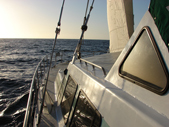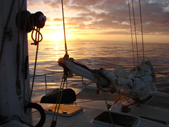Our location as of noon today: Latitude: 2223.99 North, Longitude: 16128.85 West
Welcome to our Spanish speaking friends! (See translated update below!!)
We’re thrilled to have so many schools with us again. Some of you joined the ORV Alguita on her last voyage from Los Angeles to Hawaii, and some of you are just signing on. We look forward to sharing our experiences with all of you, and would love to hear from you as well – send us your questions, comments, or thoughts and we will do our best to respond.
For our new students a brief word about the purpose of this journey:
We’re heading to an area of the ocean called the North Pacific Gyre to collect data on the amounts of plastic debris in the surface waters.
To collect this information, we use a Manta Trawl – like the one you see here in this photo:

The Manta Trawl has a fine mesh tube at the end, which collects anything larger than .333 microns. We launch the Manta Trawl off of our boat, and drag it along the ocean surface for up to 2 hours. When we reel it in, we find all sorts of interesting creatures –jellyfish, salps, copepods, lantern fish, etc., along with increasing amounts of plastic. We preserve these samples in a jar with formalin, to take back to our labs for analysis.
Back in the lab, our volunteers separate out all of the plastic particles, so we can compare the weight of plastic to the total weight of the biomass. This gives us a ratio of plastic to plankton, and gives us an idea of just how much plastic is accumulating in our oceans and potentially competing with plankton as a food source.
So far, we’ve seen evidence of plastic in all 6 samples, though we won’t know exactly how much until we return.
The Algalita Marine Research Foundation has been studying plastic debris in the North Pacific Gyre for over ten years. What makes this voyage different is that were heading to an area that has never been sampled, where we may possibly find the largest accumulation of debris ever seen.
Crossing the Pacific Ocean in the winter means we may hit some rocky weather…. However winter is also the time of year when debris accumulations are predicted to be the highest. This trip will help us prove this theory.
We’ve now been at sea for four days, sailing day and night to reach our next destination. There’s a lot of work to do on board – raising and lowering the sails, collecting samples, taking turns navigating while other people sleep, repairing problems on the boat, and blogging our experiences for you to share.
But there’s also plenty of down time – to read, fish, prepare meals, catch up on sleep, look for whales and seabirds, and enjoy being in the middle of the ocean – here’s our Captain, Charles Moore, taking an unusual bath off the back of the boat!
By tomorrow morning we will be in Necker Island, one of the southernmost Islands in the Northwest Hawaiian Islands Marine National Monument (NHWMNM). Check back tomorrow to see what we find in our samples, and to learn a bit more about the Hawaiian Islands MNM.
Aloha and thank you from the ORV Crew!
-----------------------------------------------------------------
Bienvenidos a nuestros amigos Hispanohablantes!
Nuestra ubicacion al mediodia hoy: Latitud: 2223.99 Norte, Longitud: 16128.85 Oeste
Nos da un placer enorme que tantas escuelas nos acompanen de nuevo. Algunas de ustedes participaron con el ORV Alguita en el ultimo viaje de Los Angeles a Hawaii, y algunas acaban de juntarnos. Nos anima la oportunidad de compartir nuestras experiencias con todos ustedes, y nos encantaria recibir noticias suyas – escribenos tus preguntas, comentarios u ideas, y hacemos todo lo posible para responder.
Para nuestros estudiantes nuevos, les contamos un poco sobre la intencion de esta investigacion:
Nos dirigimos hacia una region del oceano que se llama el giro del Pacifico Norte para recoger datos sobre la canditad de plastico en el oceano.
Para recoger ese clase de informacion, usamos un equipo que se llama la Draga Manta, como ves aqui en la foto:

La Draga Manta tiene un especie de red muy fino que colleciona cualquier cosa que sea mas grande que .33 micronos. Botamos la Manta desde la embarcacion y lo arrastramos por la superficie del agua. Cuando la sacamos, encontramos unas cuantas especies de criaturas fascinantes – las medusas, las salpas, copepodos, peces brilliantes y mas, pero tambien vemos unas cantidades crecientes de plastico. Preservamos las muestras en unas jarras con formol, y los traemos a nuestro laboratorio para analizarlas.
En el laboratorio, nuestros voluntarios separan todos los particulos plasticos para que podamos comparar el peso del plastico al peso del plankton. Con eso, averiguamos la proporcion de plastico a plankton, y nos da una idea de cuantos particulos se estan accumulando en nuestros oceanos - a lo mejor estan en competencia con el plankton como una fuente de alimentacion.
Ya hemos visto pruebas de plastico en todas las muestras hasta hoy, aunque no sabremos exactamente cuantas hasta que volvamos.
El
Algalita Marine Research Foundation lleva diez anos investigando el asunto del plastico en el giro del Pacifico Norte. Este viaje es distincto a los otro en que nosotros vamos a una region que todavia no se ha estudiado, en donde es posible que encontremos la accumulacion de basura mas grande que hay.
Cruzar el mar pacifico en el invierno significa que capaz tropezemos con tiempo algo dificil…..pero el invierno tambien es cuando la accumulacion de basura puede ser mas grande. La investigacion que hacemos nos ayuda en comprobar ese teoria.
Ya llevamos cuatro dias en el mar, navegando dia y noche para alcanzar nuestra destinacion. Hay bastante trabajo en el barco – alzar y bajar las velas, recoger las muestras, participar cada uno en hacer la navegacion para que los otros duerman, arreglar problemas con el barco, y escribir en el blog para que ustedes compartan el viaje con nosotros.

Pero tambien hay tiempo para relajar – leer, pescar, cocinar, dormir, buscar las ballenas y las aves marinos, y disfrutar estar en el medio del oceano – aqui ves nuestro Capitan, Charles Moore, banandose un una manera graciosa detras del barco!
Esperamos llegar por la manana en la Isla Necker, una de las Islas mas surena del Northwest Hawaiian Islands Marine National Monument (NHWMNM). Si vuelvan manana, pueden ver lo que descubrimos en nuestras pruebas, y aprender un poco mas de las Islas de Hawaii.
Aloha y gracias de la tripulacion del ORV Alguita!
 Our noon position: Latitude: 32 46.18 North, Longitude 170 03.41 West
Our noon position: Latitude: 32 46.18 North, Longitude 170 03.41 West


























